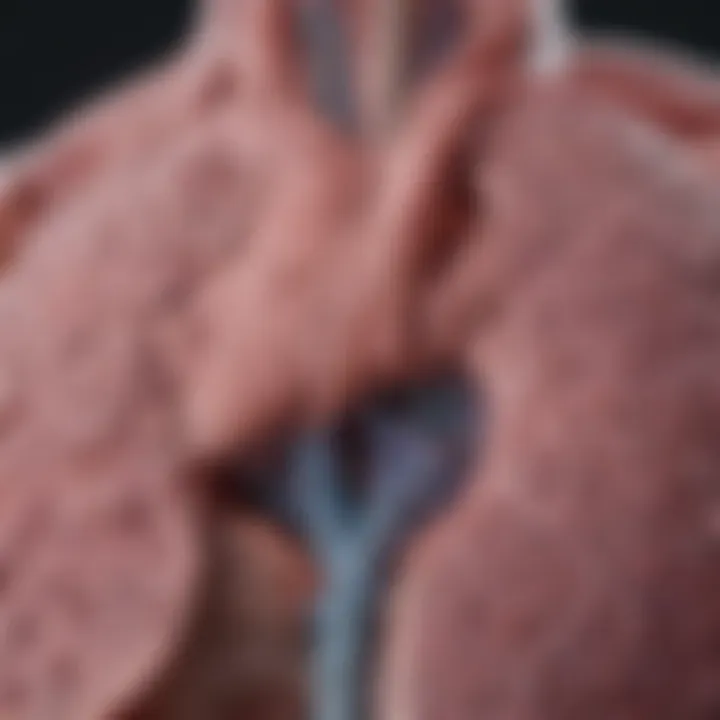Understanding Lung Squamous Cell Carcinoma: Chemotherapy Insights


Intro
Squamous cell carcinoma (SCC) of the lung represents a significant subset of non-small cell lung cancer. This type of cancer originates from the squamous cells lining the airways. The diagnosis often comes late due to subtle initial symptoms. This leads to challenges in treatment and overall management. Understanding this disease is crucial for medical professionals and researchers alike.
SCC’s treatment primarily involves chemotherapy, which has evolved over the years. As new regimens and protocols emerge, it is vital to understand their implications on patient outcomes. This article aims to shed light on various chemotherapy approaches used against lung SCC, their effectiveness, and associated side effects. The discussion also encompasses current research initiatives that may improve treatment efficacy in the future.
Research Overview
Summary of Key Findings
In recent years, studies have shown that SCC of the lung has distinct biological and molecular characteristics compared to other lung cancers. Key findings indicate that patients with SCC respond variably to chemotherapy, partly due to genetic aberrations such as mutations in TP53 and PIK3CA.
- Chemotherapy regimens, like carboplatin and paclitaxel, are commonly used but may not provide the same level of effectiveness across all patients.
- Recent advancements in targeted therapies have shown promise, particularly in cases with specific mutations.
- Immunotherapy is also gaining traction as a viable option for certain patient populations.
Overall, understanding these factors can inform more personalized treatment options for patients.
Relevance to Current Scientific Discussions
The relevance of studying SCC of the lung lies not only in its high incidence rates but also in the continuous evolution of treatment modalities. Current scientific discussions emphasize the importance of identifying biomarkers that predict chemotherapy response. Enhancing understanding in this area is essential for tailoring treatment plans better. Ongoing trials aim to explore combinations of chemotherapy with newer agents, potentially improving outcomes for this challenging disease.
Methodology
Research Design and Approach
This section examines the methodologies employed in gathering data about SCC of the lung and its treatment approaches. Most studies use a combination of retrospective analyses and prospective trials.
- Retrospective analyses provide insights based on historical patient data, identifying patterns and treatment outcomes.
- Prospective trials allow researchers to evaluate new chemotherapy strategies in a controlled environment, often in conjunction with new therapies.
Data Collection and Analysis Techniques
Data is often collected from various sources, including:
- Clinical registries that track patient demographics, treatment plans, and outcomes.
- Patient surveys that gauge health-related quality of life after treatment.
- Biological samples for further molecular analysis.
Analytical techniques range from statistical modeling to machine learning algorithms, which help delineate the efficacy and safety of differing chemotherapy regimens.
"An in-depth understanding of treatment methodologies is essential to advance therapeutic strategies in lung SCC."
By synthesizing this information, researchers can identify gaps in treatment and propose new avenues for clinical exploration.
Prolusion to Squamous Cell Carcinoma
Squamous cell carcinoma (SCC) of the lung is a significant subtype of lung cancer, representing a major focus within oncology. Understanding this form of cancer is crucial for several reasons. Firstly, SCC is often related to specific risk factors, such as smoking, which makes prevention and early detection imperative. Additionally, the biological behavior of SCC can influence treatment choices and patient outcomes, emphasizing the need for thorough knowledge of its characteristics.
The discussions that follow will delve deeper into the nature of SCC, from its definition to its epidemiology. These insights are key in tailoring effective treatment strategies and improving the overall management of patients diagnosed with this condition.
Definition and Characteristics
Squamous cell carcinoma is a malignant tumor that arises from squamous cells, which are flat cells found lining various organs, including the lungs. This type of lung cancer typically develops in the central airways. One of the defining characteristics of SCC is its association with keratin production, a feature not commonly seen in other lung cancer types. This leads to unique histological features that can be identified under a microscope, aiding in diagnosis.
Patients often present with symptoms such as a persistent cough, hemoptysis, and weight loss, which may be exacerbated in more advanced stages of the disease. The development of SCC is frequently connected to long-term exposure to carcinogens, primarily tobacco smoke, making epidemiological insights vital for healthcare strategies aimed at prevention.
Epidemiology and Prevalence
Epidemiologically, squamous cell carcinoma of the lung poses a significant burden globally. It is considered one of the major subtypes of lung cancer, accounting for around 25-30% of all lung cancer cases. The prevalence of SCC is notably higher among males, particularly older individuals with a history of smoking.
Geographically, the incidence of SCC shows variations depending on factors such as socioeconomic status, geographic location, and smoking rates among the population. Emerging studies indicate a rising prevalence among non-smokers, suggesting that other environmental and genetic factors may contribute to its development. Understanding these epidemiological trends is vital for public health initiatives aimed at risk reduction and early detection in high-risk groups.
Pathophysiology of Lung Squamous Cell Carcinoma
Understanding the pathophysiology of lung squamous cell carcinoma (SCC) is crucial in grasping how this disease develops and progresses. This section elucidates the cellular and molecular aspects that underlie squamous cell carcinoma, which, in turn, influences therapeutic choices and patient management strategies. By delving into the origin, development, and genetic factors involved, we can better appreciate the challenges and opportunities in treatment and research.
Cellular Origin and Development
Lung squamous cell carcinoma originates from the epithelial cells in the lungs. These cells, normally responsible for providing a protective barrier, undergo changes due to various insults, most notably smoking. Continuous exposure to harmful substances leads to cellular damage, resulting in mutations.
Typically, the development of squamous cell carcinoma follows a sequence known as the multistep carcinogenesis model. Early stages might involve dysplasia, where cells exhibit abnormal growth but are not yet cancerous. As genetic mutations accumulate over time, these cells can progress to carcinoma in situ and eventually invasive cancer.
Key characteristics of the progression include:
- Dysregulation of Cell Cycle: Mutations often affect genes such as TP53 and CDKN2A, disrupting normal cell cycle regulation.
- Loss of Apoptosis: Cancer cells develop mechanisms to evade programmed cell death, allowing abnormal cells to proliferate unchecked.
This step-wise progression provides critical insight into identifying potential biomarkers for early detection and developing interventions that target specific stages of the disease.
Genetic and Molecular Alterations
Molecular alterations in squamous cell carcinoma are pivotal in its pathogenesis. Such changes directly influence both tumor behavior and response to treatment. Genetic mutations commonly observed in lung SCC include changes in oncogenes and tumor suppressor genes.


- Oncogenes: Substantial data shows that gene alterations such as activating mutations in K-Ras can lead to more aggressive tumor phenotypes.
- Tumor Suppressor Genes: Alterations in genes like TP53 often result in loss of critical regulatory functions, promoting uncontrolled cell growth.
Recent advancements in understanding the genetic landscape of lung SCC emphasize the role of epigenetic modifications, such as DNA methylation and histone modifications. These changes can alter gene expression without affecting the underlying DNA sequence, leading to tumor progression.
The exploration of these genetic facets has significant implications for personalized medicine, as targeted therapies can be developed based on the specific mutations present in tumors.
"Understanding the genetic and molecular alterations in squamous cell carcinoma is essential for developing targeted treatments and improving survival rates."
In summary, the pathophysiology of lung squamous cell carcinoma reveals a complex interplay of genetic, molecular, and environmental factors. This framework not only aids in the understanding of SCC but also underscores the importance of ongoing research efforts aimed at improving therapeutic strategies and patient outcomes.
Diagnosis of Squamous Cell Carcinoma
The diagnosis of squamous cell carcinoma (SCC) is crucial in determining the appropriate treatment and management plan for affected patients. Early and accurate diagnosis can significantly influence patient outcomes. Thus, emphasis on clinical presentation, diagnostic imaging, and histopathological examination is essential. Each component plays a vital role in identifying the disease's characteristics and staging, which ultimately guides therapeutic decisions.
Clinical Presentation and Symptoms
Clinical presentation of lung SCC often varies. Patients may experience a range of symptoms such as persistent cough, chest pain, and hemoptysis. These signs can frequently be mistaken for more common respiratory conditions, leading to delays in diagnosis. Additionally, weight loss and fatigue are common systemic symptoms in patients with lung cancer. It is worth noting that early recognition of these symptoms is critical for timely intervention. Physicians should maintain a high index of suspicion, especially in individuals with significant risk factors, such as a history of smoking. Regular monitoring in high-risk groups can aid in early detection.
Diagnostic Imaging Techniques
Diagnostic imaging techniques are pivotal in locating and characterizing lung tumors. Common imaging modalities include chest X-rays, computed tomography (CT) scans, and positron emission tomography (PET) scans. A chest X-ray can often reveal abnormalities; however, it lacks the specificity needed to confirm a diagnosis. CT scans provide a more detailed view and help in assessing tumor size, location, and involvement of nearby structures. PET scans are particularly useful in evaluating metastasis, aiding significantly in staging the disease. The integration of these imaging techniques allows for a comprehensive assessment of the tumor burden, which is vital for appropriate therapeutic planning.
Histopathological Examination
Histopathological examination remains the gold standard for diagnosing lung SCC. This involves the analysis of tissue samples obtained through biopsy. A trained pathologist evaluates the cellular characteristics under a microscope, looking for histological features that are consistent with squamous cell carcinoma. The presence of keratinization and intercellular bridges can help distinguish SCC from other lung cancers. Immunohistochemistry can further enhance diagnostic accuracy by identifying specific markers associated with SCC. The findings from histopathological assessments provide not only definitive diagnosis but also important prognostic information, guiding the overall management plan for the patient.
Accurate diagnosis of squamous cell carcinoma can substantially impact treatment choices and improve patient outcomes. Early detection is crucial for effective intervention.
In summary, the diagnosis of squamous cell carcinoma involves a multifaceted approach that combines evaluations of clinical presentation, sophisticated imaging techniques, and detailed histopathological analyses. Each layer of this diagnostic process contributes significantly to the formulation of a strategic and personalized treatment plan.
Understanding Chemotherapy for Lung SCC
Chemotherapy plays a critical role in treating squamous cell carcinoma (SCC) of the lung. It is often used either as a primary treatment, or in combination with other therapies such as surgery or radiation. Knowledge about chemotherapy for lung SCC is essential for effective patient management. The benefits include tumor shrinkage, increased survival rates, and improvement in symptoms. However, considerations about side effects and appropriate regimens must be carefully evaluated.
Mechanisms of Action
Chemotherapy works by targeting rapidly dividing cells, a common characteristic of cancer. The primary mechanisms of action include:
- Alkylating agents: These drugs damage DNA, preventing cancer cells from replicating. By disrupting the cell cycle, it helps to reduce tumor size or prevent further growth.
- Antimetabolites: They interfere with DNA and RNA synthesis, substituting for the building blocks needed for cell division. This halts the proliferation of cancer cells.
- Mitotic inhibitors: These disrupt cell division by targeting the microtubules, essential for chromosome segregation during mitosis.
- Topoisomerase inhibitors: They prevent the repair of DNA strands after replication leading to cell death.
These mechanisms work synergistically, aiming to maximize the damage to cancer cells while minimizing harm to normal cells, although this is not always successful. Understanding these mechanisms helps in tailoring individualized treatment plans.
Common Chemotherapeutic Agents
Several chemotherapeutic agents are commonly utilized in managing lung SCC. They include:
- Cisplatin: This platinum-based drug is often combined with others. It provides a high level of efficacy against squamous cell tumors but can have serious side effects, such as nephrotoxicity.
- Carboplatin: A derivative of cisplatin, used in patients who may have higher risks of side effects from cisplatin. It has a different toxicity profile.
- Paclitaxel: Works by inhibiting cell division through the stabilization of microtubules. It is frequently used in regimens with other drugs.
- Docetaxel: Similar to paclitaxel, it also impacts microtubule dynamics and is effective even after other treatments.
- Gemcitabine: An antimetabolite that is used to treat various malignancies, including lung SCC.
- Vinorelbine: Has a specific action on the cell cycle and is often included in treatment regimens.
Understanding these agents and their applications is crucial for healthcare providers and patients alike. The choice of regimen may depend on several factors including the patient's overall health, specific cancer characteristics, and previous treatments.
Chemotherapy Regimens for Squamous Cell Carcinoma
Chemotherapy regimens for squamous cell carcinoma of the lung are critical in managing the disease. They represent the backbone of treatment for patients with advanced stages of this cancer type. These regimens are designed to optimize therapeutic outcomes, manage tumor progression, and enhance survival rates. Understanding these regimens, including how they are structured and adjusted, is essential for both healthcare providers and patients alike.
Standard Treatment Protocols
Standard treatment protocols for squamous cell carcinoma often include drug combinations that have shown efficacy in clinical trials. Common agents in these regimens include cisplatin, carboplatin, and docetaxel. Here are some notable aspects:
- Cisplatin: Often used in combination with other agents, cisplatin is a platinum-based drug that interferes with the DNA of cancer cells. It is typically administered in the initial stages of treatment.
- Carboplatin: Similar in action to cisplatin, carboplatin may be preferred in patients who experience significant side effects from cisplatin.
- Docetaxel: This taxane compound works by disrupting the cell cycle, preventing cancer cells from dividing. It is often included in treatment regimens in conjunction with platinum-based agents.
The combination of these drugs aims to achieve a synergistic effect, increasing the overall efficacy of the treatment. Notably, treatment regimens can vary based on tumor characteristics, patient's physical condition, and previous treatment history.
Dose Modifications and Adjustments
Dose modifications are a vital component when considering chemotherapy regimens. Individual patient responses to chemotherapy can vary widely, necessitating personalized adjustments to dosages. Several factors to consider include:
- Toxicity management: Chemotherapy can cause significant side effects, including nausea, fatigue, and neutropenia. When patients experience severe toxicity, healthcare providers may reduce the dosage or extend treatment intervals to allow for recovery.
- Renal function: The function of a patient's kidneys can affect drug clearance, particularly for drugs like cisplatin. Assessment of renal function is crucial before administering these agents to avoid complications.
- Overall health status: Age, performance status, and comorbidities also influence dose adjustments. Older patients or those with additional health concerns may require a more conservative approach.
"Personalization in chemotherapy regimens can lead to better tolerance and effectiveness, benefiting long-term outcomes for patients."
Patient Management During Chemotherapy
Effective patient management during chemotherapy is essential for optimizing treatment outcomes and enhancing the quality of life in patients suffering from squamous cell carcinoma of the lung. Chemotherapy, while a crucial treatment modality for this type of cancer, often comes with significant adverse effects that can compromise the patient's health and well-being. Therefore, a robust management strategy that addresses these challenges is critically important.
First, continuous monitoring is important to identify any adverse effects early. Understanding the distinct side effects associated with specific chemotherapeutic agents allows healthcare providers to implement timely interventions. Furthermore, the aim is to maintain the patient's overall health status while managing the cancer aggressively. Accessibility to mental health support and nutritional guidance should also be included in patient management strategies to support the whole person.
Adapting the treatment approach can enhance adherence to chemotherapy regimens. In this way, patient education becomes valuable. Patients who understand the purpose of their treatment and the possible side effects may be more likely to engage actively with their healthcare teams, leading to better outcomes. Communication between patients and providers fosters a supportive environment necessary for effective treatment.


Monitoring for Adverse Effects
Monitoring for adverse effects is a key component of managing patients undergoing chemotherapy. Standard treatment protocols for squamous cell carcinoma often include drugs like Cisplatin and Docetaxel, known for their efficacy but also for their potential to induce several side effects.
Common adverse effects include:
- Nausea and vomiting
- Fatigue
- Bone marrow suppression, leading to increased risk of infections
- Anemia
- Mucositis, which can cause pain and discomfort in the mouth and digestive tract
Regular assessments help track these adverse effects. Blood tests, for instance, allow clinicians to gauge the bone marrow function, while patient-reported outcomes can reveal symptoms that might be affecting daily life. Prompt mitigation strategies are essential. For example, anti-nausea medications can be given before chemotherapy to improve patient comfort. This proactive approach significantly contributes to patient retention and adherence to treatment plans.
Supportive Care Strategies
Supportive care strategies serve as a fundamental layer in the management of patients with squamous cell carcinoma during chemotherapy treatment. These strategies are designed to manage symptoms, improve quality of life, and help patients cope with the psychological toll of a cancer diagnosis.
Common supportive care measures may include:
- Nutritional Support: Personalized dietary plans can enhance patient strength and aid recovery. Patients may require specific nutrient-dense foods to combat fatigue and improve their immune response.
- Pain Management: Adequate pain relief is crucial. This can involve medications like acetaminophen or opioids as needed, along with non-pharmacological interventions such as physical therapy.
- Emotional and Psychological Care: Engaging social workers or counselors can provide mental health support. Group therapy or support groups can help build a community for patients, reducing feelings of isolation and anxiety.
- Palliative Care Options: These involve integrating palliative care specialists early in the treatment to address complex symptoms and support goals of care discussions.
Ultimately, effective patient management during chemotherapy demands an interdisciplinary approach combining medical treatment with supportive care strategies that focus on both physical and mental health. This comprehensive view not only addresses the medical needs but also recognizes the imperativeness of emotional support and lifestyle adjustments.
Potential Side Effects of Chemotherapy
Chemotherapy is essential in treating squamous cell carcinoma of the lung. However, it comes with a range of side effects that can significantly affect patients' quality of life. Understanding these potential side effects is crucial for both healthcare providers and patients. Managing expectations and preparing patients for what they might encounter during treatment plays a significant role in their overall care.
One of the major components in discussing side effects is the differentiation between common reactions and severe ones. Common reactions can include nausea, fatigue, and hair loss, which often resolve after treatment discontinuation. Severe reactions, although less frequent, can be life-threatening and require immediate attention.
Moreover, long-term consequences of chemotherapy can impact patients years after their initial treatment. Surveillance for these potential outcomes is necessary, as they can affect overall health and monitor recurrence of cancer. Thus, a thorough understanding is vital for quality care and ongoing patient support.
Common and Severe Reactions
Common Reactions
Most patients undergoing chemotherapy experience some common side effects. These may include:
- Nausea and vomiting: This can be managed with medication.
- Fatigue: Generally leads to decreased energy levels.
- Hair loss: Often temporary but can be distressing.
- Loss of appetite: Change in tastes and preferences.
These reactions are typically manageable and improve after the completion of the chemotherapy regimen.
Severe Reactions
Severe reactions can occur and often require urgent medical intervention. Some of these can be:
- Severe allergic reactions: This can happen with certain drugs.
- Infection risk: Chemotherapy can lower white blood cell counts, making patients vulnerable to infections.
- Organ damage: Certain agents may lead to damage in organs such as the heart or kidneys.
Understanding the potential for these severe reactions is important for timely intervention and minimizing health risks.
Long-Term Consequences
Patients who undergo chemotherapy may face long-term effects that can alter their health status and lifestyle.
Factors to Consider
- Chronic Fatigue: Some patients experience fatigue that persists long after treatment.
- Pulmonary Issues: Damage to lung tissue may occur, increasing the risk for respiratory issues.
- Secondary Cancers: There is an elevated risk for developing other types of cancer due to the aggressive nature of chemotherapy agents.
Regular follow-ups and monitoring are recommended to address these long-term effects effectively. Awareness of these potential consequences allows for proactive management and optimizes patient care.
"Understanding the implications of chemotherapy's side effects can greatly improve patient experience during treatment."
Emerging Treatments and Research
The field of squamous cell carcinoma of the lung is continuously evolving. Emerging treatments and ongoing research hold the key to improving patient outcomes and refining existing therapies. Understanding these advancements is crucial for practitioners and patients alike. Many factors influence this area, including technological innovations, genetic insights, and the development of new medication. As more variables enter the equation, the treatment landscape becomes more complex yet promising.
Targeted Therapies
Targeted therapies are designed to interfere with specific molecular targets associated with cancer. In squamous cell carcinoma, this approach has shown great potential. Such therapies can inhibit pathways that promote tumor growth and provide more effective options than conventional chemotherapy. One significant target in this category is the epidermal growth factor receptor (EGFR).
The benefits of targeted therapies are notable: they often have fewer side effects compared to traditional chemotherapy. For example, drugs like erlotinib and gefitinib have been effective in certain patient populations. However, not all patients respond to targeted therapies, which can limit their overall impact on survival rates. Genetic testing can aid in identifying patients who are most likely to benefit.
Considerations
- Access and Cost: Targeted therapies can be expensive, which presents a challenge in healthcare settings.
- Resistance Development: Over time, cancer cells may develop resistance to targeted treatments, necessitating ongoing research.
- Testing Requirements: Genetic biomarkers need to be tested before starting targeted treatment, which adds a layer of complexity in patient management.
Immunotherapy Options
Immunotherapy represents another front in the battle against squamous cell carcinoma. This form of treatment aims to harness the body’s immune system to fight cancer. Agents such as pembrolizumab and nivolumab, both checkpoint inhibitors, have created substantial interest due to their efficacy in some patients.
These medications work by blocking proteins that inhibit the immune response against cancer cells. As a result, the immune system is better equipped to locate and destroy cancerous cells. Immunotherapy can lead to durable responses, significantly improving overall survival in some cases.


Considerations
- Patient Selection: Not every patient will respond to immunotherapy. Identifying suitable candidates is essential for maximizing benefits.
- Potential Side Effects: Patients may experience immune-related adverse effects, including pneumonitis, colitis, or endocrinopathy.
- Research Landscape: Ongoing clinical trials continue to explore various combinations and sequences of immunotherapy with other treatments to enhance effectiveness.
"The future of squamous cell carcinoma treatment lies in the ability to integrate these innovative approaches into clinical practice, ensuring personalized therapy for every patient."
The Role of Clinical Trials
Clinical trials are critical in advancing the understanding and treatment of squamous cell carcinoma (SCC) of the lung. They play a significant role in assessing new therapies, refining existing methods, and evaluating the safety and efficacy of various treatment protocols. Clinical trials provide a controlled environment where researchers can gather data that may lead to improvements in patient care.
One of the most pertinent functions of clinical trials is their contribution to treatment advancement. They allow for the exploration of innovative approaches that might not be available in regular treatment settings. Trials often focus on evaluating new drugs, combination therapies, and the timing of treatment doses. By rigorously testing these elements, researchers can identify optimal strategies that might enhance survival rates and reduce side effects.
Importance in Treatment Advancement
The importance of clinical trials cannot be overstated. They bring several benefits:
- Safety assessment: Before new treatments can reach wider patient populations, they must undergo extensive safety evaluations. Trials ensure that these drugs do not pose undue risks to patients.
- Efficacy determination: Trials are essential for determining whether a new treatment works better than standard therapies.
- Exploration of biomarkers: Clinical trials often focus on identifying biomarkers that can predict how well a patient will respond to a specific treatment. This can lead to more personalized therapies.
- Long-term data collection: Participants in clinical trials can provide data over extended periods, which is vital for understanding long-term outcomes.
These factors contribute to the continuous improvement of how lung SCC is managed. By participating in or supporting clinical trials, stakeholders can help push the boundaries of knowledge and potential treatment options.
Current Clinical Trials for Lung SCC
At present, various clinical trials are addressing different aspects of lung SCC treatment. Some focus on immunotherapy, examining how patients react to drugs that stimulate the immune system to fight cancer. Others are exploring combinations of traditional chemotherapy with targeted therapies or newer drugs designed to disrupt the cancer cell cycle.
Ongoing trials also include:
- Evaluation of novel agents like Atezolizumab and Nivolumab.
- Studies combining chemotherapy with radiation therapy in specific patient populations.
- Trials assessing the effectiveness of new drug delivery systems, such as nanoformulations, which aim to enhance the bioavailability of chemotherapeutic agents.
In summation, the collective efforts in clinical trials are pivotal in shaping the future of lung SCC treatment. They generate critical insights that influence clinical practice and policy decisions, ultimately contributing to improved patient outcomes.
Long-Term Outcomes and Survivorship
Long-term outcomes in patients diagnosed with squamous cell carcinoma of the lung are critical for understanding the effectiveness of treatment approaches, particularly chemotherapy. This section explores how patient survival rates, response to therapy, and overall quality of life evolve over time following a lung SCC diagnosis. A comprehensive understanding of these outcomes can guide clinicians in developing individualized treatment plans and provide patients with realistic expectations during their cancer journey.
The assessment of survivorship encompasses various aspects. First, clearly defined survival rates are essential, as they give insights into the likelihood of disease-free intervals. Survival can be influenced by many factors, including stage at diagnosis, age, general health, and response to initial therapies. Recognizing survival statistics can be motivating for patients as they navigate treatment.
Additionally, survivorship extends beyond survival metrics to include psychosocial factors. The emotional and mental health of patients after treatment can drastically affect their journey. Resources and support systems play a significant role in helping patients manage feelings of isolation or anxiety, which can persist even after primary treatments conclude.
Moreover, long-term management involves monitoring for recurrence of the disease. Oncologists often emphasize follow-up care, where regular scans and check-ups help monitor for signs of returning cancer. Survivors should remain vigilant, as early detection of recurrence can allow for prompt intervention.
“Understanding the long-term journey of lung SCC survivors requires not only monitoring clinical symptoms but also addressing emotional and practical challenges.”
In summary, recognizing the long-term outcomes associated with lung squamous cell carcinoma ensures that healthcare providers focus on more than just survival. This holistic approach encapsulates improved patient management, the potential for enhanced quality of life, and a structured follow-up care plan.
Factors Influencing Prognosis
Numerous elements affect the prognosis of lung SCC, making it essential to consider these factors when discussing long-term outcomes. An individual’s initial stage at diagnosis plays a crucial role in shaping survivorship. Patients presenting with localized tumors typically have better outcomes than those with metastatic disease.
Another influential aspect is the patient's age and overall health. Younger patients often experience fewer treatment-related complications and may respond better to chemotherapy.
Genetic factors also play a role. For instance, mutations in specific genes can impact both prognosis and treatment response. Patients with identifiable molecular characteristics might be candidates for targeted therapies or trials, providing possible alternatives that can improve their prognosis.
In addition, treatment adherence can significantly influence outcomes. Patients who complete their recommended therapies are likely to achieve better long-term benefits. Those who do not follow through with treatment may see a decline in their prognosis due to the untreated nature of the disease.
Quality of Life Post-Chemotherapy
The quality of life for patients recovering from lung SCC, particularly after chemotherapy, is a vital concern for both patients and healthcare providers. Many patients experience a range of emotional, physical, and social burdens that can persist even after the conclusion of therapy.
Physical effects are often prominent. Many patients report fatigue, pain, or lasting changes in physical abilities. Addressing these concerns through rehabilitation services can help patients regain their strength and functionality.
Emotional and psychological well-being also requires attention. Anxiety, depression, and fear of recurrence are not uncommon. Support groups or counseling can provide strategies to manage these issues effectively. Participating in community activities can enhance social connectedness, promoting a better quality of life.
Furthermore, the practical implications of cancer treatment can affect day-to-day living. Patients may need assistance transitioning back to work or other activities. It is essential for healthcare providers to prepare patients for this phase by offering resources and supportive measures.
Culmination and Future Directions
The conclusion of any discussion on squamous cell carcinoma (SCC) of the lung reflects on the current state of knowledge and points towards future strategies for improvement in treatment and patient care. It is crucial to recognize the dynamic nature of cancer research. The understanding of SCC has evolved significantly, and implications for treatment are profound. Here, the insights gained enable healthcare professionals to enhance therapeutic approaches, ensuring better patient outcomes.
In summary, the advancement of SCC treatment involves a multifaceted approach. Continued research and clinical trials play an integral role in refining chemotherapy protocols. Moreover, it enables diversification in treatment strategies, leading to personalized medicine. Adapting therapeutic regimens according to the unique profile of each patient promises improved effectiveness.
Summary of Current Understanding
Current findings in lung squamous cell carcinoma illuminate the importance of early detection and the integration of chemotherapy with emerging therapies. Historically, SCC has been linked with risk factors such as smoking and environmental exposure. It is crucial to continue educating patients about prevention strategies, including smoking cessation programs. Research efforts in understanding genetic markers associated with SCC pave the way for targeted therapies, enhancing treatment specificity.
Recent advancements focus on the development of novel agents that are designed to target specific pathways critical for cancer cell survival. This ongoing transition from traditional treatments to more personalized medicinal approaches introduces new hope for effective control of the disease.
Impact of Ongoing Research on Treatment
The realm of ongoing research significantly influences the future of lung SCC treatment. Investigations into targeted therapies have revealed promising pathways that allow for customization of treatment plans based on genetic profiles. Furthermore, clinical trials offer vital data that help identify which combinations of chemotherapy and immunotherapy yield optimal results.
Ongoing studies emphasize the necessity for interdisciplinary collaboration among oncologists, researchers, and patient advocacy groups. By pooling resources and knowledge, the entire field stands to gain. New findings not only enhance the therapeutic landscape but also inform guidelines for patient management, ultimately striving for improved quality of life.
"The collaboration in cancer research can lead to breakthroughs that are essential for the management of diseases like SCC."
Moreover, the evolution of research methodologies has improved the precision of data analysis, allowing for faster identification of therapeutic targets. With access to real-time data, professionals can respond to the shifting landscape of lung cancer treatment, adapting practices to incorporate the latest evidence. This responsiveness ensures that patients receive cutting-edge care tailored to their specific clinical scenarios.



